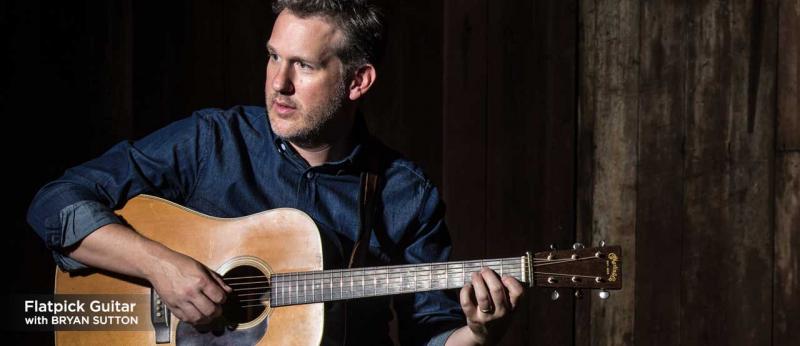How to Play Alternate Downbeat Notes on Guitar
Flatpicking: Playing Alternate Downbeat Notes

Need something new to spice up your bluegrass or country rhythm technique? Look no further, because today we’re going to discuss three great ways to elaborate even the simplest of progressions.
Not yet a member of Bryan Sutton's Flatpick Guitar School? Get free lessons and join today.
What is it about open chords?
When most people think of bluegrass or country rhythm, open chords are one of the first things that come to mind. Let’s first cover a bit of background on open chords.
Open chords have traditionally been favored because they require fewer fretted notes, making the job of the left hand easier. Also, open strings are more resonant than fretted notes because they aren’t dependent on contact with the left hand to sustain the pitch. Ultimately, the more open strings are used, the more freedom the left hand has to explore the neck.
A surprising number of musical phrases can be found even on the first few frets of the guitar when the left hand is free to roam. Let’s look at a crucial technique for animating your open chord playing: alternating bass.
Alternating Bass with Open Chords
With this technique the player alternates between two bass notes in an open chord, with one note on beats 1 and 3 and the other on 2 and 4. In waltz (¾) time, the bass notes change on the first beat of each measure. Eighth note strums on the treble strings fill the spaces between each bass note.
Also known as the ‘boom-chuck’ pattern, the ‘booms’ are the bass notes and the ‘chucks’ are the strums that occur between the stronger beats.
Traditionally, guitarists have alternated bass notes in fifths to imitate the sound of the upright bass. There are other ways to do this, which we’ll discuss below.
Let’s take a G major chord in open position. Play the 6th string, following it with two eighth note strums (down-up) on the treble strings. Next, play the 5th string, following it with the same down-up strums on the treble strings. This is beat two. Return to the 6th string for beat three, and to the 5th string for beat four.
Always play bass notes with a downstroke. This drives the music by emphasizing the bass notes on the strong beats. The picking pattern is counted bass, down-up, bass, down-up, etc.
Once you’re comfortable with alternating bass, you’re ready to add movement to your bass lines.
Not yet a member of Bryan Sutton's Flatpick Guitar School? Get free lessons and join today.
Walking Bass: Adding Bass Notes to the Scale
In this example we’re using a moving bass line to connect the chords G major and C major. Starting with G major, play the 6th string, open 5th string, 5th string 2nd fret, and 6th string again on beat 4, filling the space between with a ‘down-up’ strum. The pattern is G, down-up, A, down-up, B, down-up, G, down-up.
Now we’re ready to move to C major. The pattern is C, down-up, D, down-up, E, down-up, C, down-up.
Using each of the open chords you know, try to hear the bass notes ascending and descending the major scale. The next note is never far away, typically located either on an open string or one fret away.
Enjoy these new rhythm techniques and let your creativity lead the way!
Not yet a member of Bryan Sutton's Flatpick Guitar School? Get free lessons and join today.
Find even more great guitar tips here:
How to Practice Guitar: The Ultimate 7 Step Guide
How to do a Muted Sweep on Guitar: A Paul Gilbert Exclusive
How to Outline Chord Changes: Guthrie Trapp
How to Play Guitar for Beginners







Comments